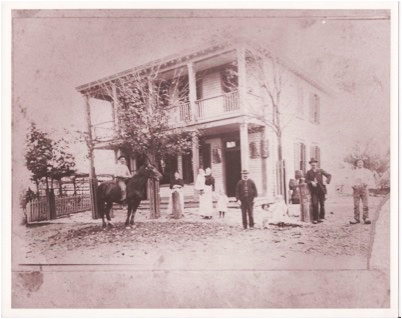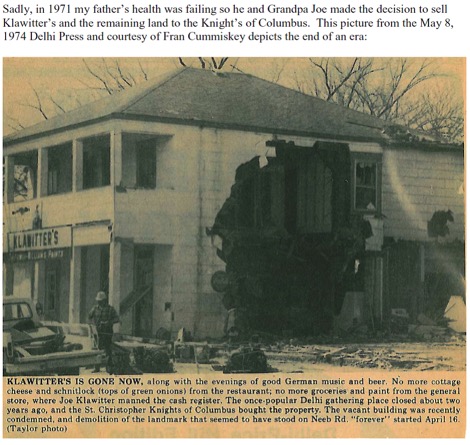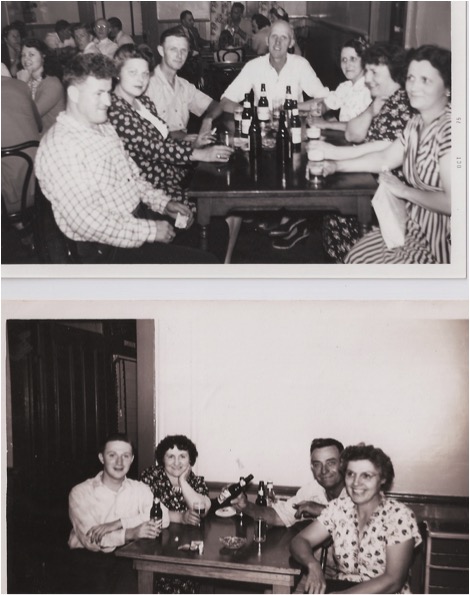By Anita Klawitter
For many Delhian’s aged about sixty and beyond, Klawitter’s was a fixture on Neeb Road. Klawitter’s was located across the street from Our Lady of Victory Church and since 1895 served primarily as a grocery store and tavern. Later the grocery store included the addition of toys and furniture, Delhi’s first bowling alley, a beer garden, reception hall, and an ice cream parlor.
I am told at one time my grandpa Joe Klawitter sold Model T cars at Klawitter’s too.Mr. Bolser who ran his service repair shop further down on Neeb Road once told me, “Anything to earn a buck your grandpa did cause he had so many mouths to feed.”In fact, as Mr. Bolser and I were talking he told me the table we were standing by in his office was purchased at Klawitter’s.
Photo: 1895, on horse is Henry Reimerink, Kate Kuper Klawitter (Proprietress), baby is Clara Miller, Theresa Reimerink-Miller Alyward, Anna Miller, Eduard Klawitter (Proprietor), dog, Joseph Klawitter, John Barnhorst, Herman Nutter
My great grandparents Eduard Klawitter and Katie Kuper Klawitter purchased the store in 1895 from the John and Lillie Brune. I’ve always been interested in it’s history as I was just a child when we sold it, but still have some vague memories, like stacking pickles at the store and my father laying my youngest sister Mary Beth on the checkout counter to get a stuck bead out of her nose!
My four brothers all remember working hard there, especially my eldest brother Joe. He was just a small child and labored endlessly helping the family business – in fact some of my cousins didn’t even know he was a relative, they thought he was the hired help! My brother Jim remembers sorting bottles in the bottle shed and keeping the refrigeration going at the store. This is how he initially learned the electrical business which would later serve him well as a master electrician with his own business. My brother Ken worked the cash register at the store and at age 14 more or less managed the ice-cream parlor business.
Peg Schmidt at the Delhi Historic Society knew of my interest in the old store and told me of a book housed at the DHS library written by Bert Myers. Bert was a Delhi native who wrote down everything she remembered about Delhi from 1908-1917 when she lived on her parent’s farm. The book is entitled “Come and Sit A Spell” and is available at the Delhi Historic Society. I was fascinated to read the line about how things were organized in a “queer assortment” at Klawitter’s. This rather stunned me as all us Klawitter kids – the offspring of Grandpa Joe – are all pretty dang organized! Following are some of the Come and Sit A Spell’s excerpts on Klawitter’s:
“I remember one 4thof July in particular, Pop decided early in the morning to have a picnic. He visited a few neighbors inviting them…The men went to the general store and saloon for a keg of beer and a block of limburger cheese. Mom provided the remainder of the lunch…”
“During the summer months every Monday and Thursday was spent preparing the produce raised on the farm for marketing. …Mom took a wagon load of vegetables, fruits, eggs, butter, cottage cheese and buttermilk to our closest suburb, a three-mile trip. One of Mom’s customers was a woman who, with her husband ran a saloon. We’d arrive around noon and sometimes Mom would get ham sandwiches for our lunch. Big slabs of fresh rye bread and layers of delicious ham for a nickel. …Even though the cookie jar at home was always full the bought ones were a real treat. They had marshmallow and nuts and chocolate, ours (at home) were plain.”
“Across the road from our church and school was a general store and saloon. It was in existence when Pop was a boy and was still standing and doing business up until 1971 when all the land was sold, and another subdivision sprang up. I can clearly remember the store and merchandise displayed. It was a queer assortment of things for sale, but I suppose a boom to the neighborhood families. I remember the candy case, can plainly see the assortment, most of the different kinds vanished from the market. Once in a while Mom would give us a nickel for candy. It would take a lot of time and figuring in order to get the most of our nickel. We usually ended up with stick candy, two sticks for a penny. They had bread and, I am not sure, but I think Streitman’s cookies. The cookies were in metal boxes similar to a bread box, with a drop-down glass door displaying the cookies. There were vanilla wafers, ginger snaps, gypsy queens, graham crackers covered with chocolate, little cookies with mounds of marshmallow covered with chocolate, some with a pecan or English walnut on top. All very tempting but the nickel didn’t go far enough for a cookie treat.
On the shelves were lamp chimneys and wicks, lanterns, thread, pins, needles, shoe laces, school supplies, candles, sardines, mops, brooms, buckets, even wooden shoes: everything all mixed up as my description. There were kerosene and turpentine barrels somewhere but I’m not sure where. The beer barrels were in another room but the bar where the beer was served was right in the grocery part. It was fun just walking around looking and being amazed at such a variety of things for sale in such a small space.”
“A day to remember and treasure was the day I was chosen to go to the blacksmith shop with my Pop. …On the way home Pop stopped at the general store and saloon to be a beer. He took me in for a soft drink. You had a choice of three drinks: mineral water, white Dewey, red; and sarsaparilla, a drink like root beer. I must have been about four years old, but I felt so ashamed of being in a saloon. I knew there were sitting rooms for the ladies, they should never be in a saloon. But oh, how I loved that Dewey!”
Another article we Klawitter kids treasure is by Peg Schmidt, Past President of the Delhi Historic Society she wrote a column on the store for the Delhi Press - here is the article:
When I was a kid, my father became ill and had no choice but to sell Klawitter’s, including the store, the “party barn,” the grounds, and our house. The brick house – which my father designed and built from his WWII savings - was bought separately and moved to Faysel Drive where it still stands today. Prior to the demolition of the store, an auction was held and sadly a lot of priceless heirlooms including old photographs, Steiff bears and a player piano were, as my mother and older brothers remember, “thrown over the hill and burned.”
We still have some items from Klawitter’s. The original parking lot sign and store front signs are in possession of my cousin Karen Klawitter-Brannan and two of my brothers. My sister Peggy – the lover of beer – has some German beer steins and I think we all have some of the restaurants juice glasses, beer mugs or vases. My sister Mary has a beautiful antique set of children’s china. My brother Ken is the proud owner of the restaurant’s hamburger maker that he still uses today. I am the owner of the giant rolling pin Mrs. Frank and others used to make pies, cookies and dough for the restaurant and party hall. I never knew Mrs. Frank but am told “she worked like a dog” for Klawitter’s as the primary cook for the tavern, restaurant and reception hall.
Below: 1947 Photo of Mrs. Frank (with the original bar in the background.) The second photo shows Mrs. Frank dressed in white and speaking with someone, apparently supervising the buffet line.
Prior to the building being torn down my brother Bob found a “secret room” within the second floor where Grandma and Grandpa raised their family and where Grandpa Joe’s own parents, Eduard and Kate, originally lived with their family. This “secret room” had a lot of old German cut glass in it. Thanks to this find each of the siblings have a vase or bowl that apparently belonged to the ancestors. Bob also had the foresight to save the original bar and even refinished it. The bar was moved to our new home in Bridgetown and resided in a place of honor in the dining room for decades until Mom sold the house. The bar then found its way to my brother Bob’s home in New Jersey for about 15 years, and in the past month it now resides at my nephew David’s home.
I also have a few rings that I “stole” from the jewelry case in 3rd grade with and OLV classmate, Rae Lynn H. Grandpa Joe was fine with us each taking 3 or 4 rings. However, when I got home Mom immediately chastised me and told me to bring them back to the store. But Dad – ever giving in to “his little Dutch girl” - said I could keep them - luckily, we still have those rings. In fact, as I grew older I noticed my mother wearing the rings quite often, and since her death I now have them. They’re only costume jewelry but anytime I wear them, I get compliments on them – which I think is a hoot considering they were stolen booty that got me in trouble.
What I wish we had MORE of are photos, if anyone has photos of the beer gardens, interior of the store/restaurant/hall please pass them on to the historical society for me! I would love to see them.
One thing I know a lot of people have of Klawitter’s - is memories. And I would love to hear about those too. I remember as a child, we were often stopped and asked if we were from the “Delhi Klawitter’s.” When we answered in the affirmative, we were told of the giant ice balls they could buy at Klawitter’s for a dime, or the “Big K” burgers or how they had first met their future spouse at Klawitter’s beer gardens or party hall, and later had their wedding receptions there. I love hearing these stories as I was just 9 years old when we sold the property. I was happy to see several years ago when the DHS did a Facebook blurb on the store so many commented on my grandpa Joe who was a giant of a man, and came off gruff, but was really a teddy bear with a great sense of humor.
Grandpa Joe Klawitter, the “gruff” teddy bear, with pregnant daughter Marion Klawitter-Westerhaus:
Grandpa Joe Klawitter 1969
Attached are a few of the photos I do have of the good times at Klawitter’s. Except for a few family members, we have no idea who these folks are. Maybe you do?
Uncle Henry Reimerink is the man closest to the radiator with the beer glasses all in a row. Henry served as a Delhi Trustee, and donated the land that some of the OLV cemetery is on, Uncle Henry lived above Klawitter’s store until his death in 1954.
Above and Below: Unknown patrons of Klawitter’s Tavern, Neeb Road with OLV school in the background
Grandpa Joe Klawitter manning the bar, other’s unknown:
This time my Dad, Florian Klawitter is manning the bar, patrons unknown to me:
Unidentified patrons at Klawitter’s: Do you know any of these people?
My parents, Florian Klawitter and Margaret Ciresi-Klawitter’s wedding reception.
More unidentified people enjoying Klawitters
Now for a sad time at Klawitter’s, a death by bowling pin. In researching my family’s genealogy, I discovered that my great grandmother Katie Kuper’s father, Francicus Kuper, died when she was just a baby in 1865. He drowned while taking a bath in the Muddy Creek. Katie’s mother, Maria would re-marry a year later to Johanne Reimerink of Losser, Holland. Maria and Johanne Reimerink went on to have four additional children – all younger step-siblings to my great grandmother Katie. Katie’s step-brother was Johann, Jr. who went by the name John. John was born in March of 1869 and died tragically at the hands of his brother-in-law 30 years later in 1899.
I have a copy of three separate articles from the August 1899 Cincinnati Times-Star Newspaper describing the incident. The headlines read as follows:
Headline 1: FATAL BLOW:A Farmer Was Killed During a Quarrel.
Headline 2: HIS SKULL CRUSHED BY BLOW WITH A TEN PIN.
Headline 3: CRUSHEDHis Head With Bowling Pin.
Lower Headline: Fight at Delhi in Which John Reimerink Was Killed by his Brother-in-law.
The longest article on John’s death reads as follows:
CRUSHED His Head With Bowling Pin.
Fight at Delhi in Which John Reimerink Was Killed by his Brother-in-law.
“Last Sunday night several men were engaged in bowling at the resort in Delhi Township. Among them were John F. Reimerink and his brother in law, John Martini, both farmers. The crowd was drinking freely, and a quarrel ensued between Reimerink and Martini. They finally came to blows, and Martini who was getting the worst of it, picked up a bowling pin and dealt Reimerink a terrible blow on the head. The latter sank to the floor unconscious, and the now sobered witnesses of the fight removed him to his home two or three miles away. Every effort was made to keep the result of the fight from being known. Reimerink being in a very dangerous condition.
The matter was reported to the authorities of the township. Finally, Dr. Finchpaugh was summoned, and he quickly saw that the chances of Reimerink recovering were very slim. He sank into a comatose state, and the most earnest of efforts on the part of the physician failed to revive him. Friday night at 10 o'clock he died and Dr. Finchpaugh notified Acting Coroner Winkler.
Yesterday morning that official went to Muddy Creek and held an inquest. The evidence presented was so convincing that Acting Coroner Winkler exercised the prerogatives of his position as Justice of the Peace and placed Martini under arrest. The young man was badly broken up over the tragic outcome of the fight, and offered no resistance. Accompanied by his father, the prisoner came to this city with Winkler, who preferred a charge of manslaughter against him. His bail was set at $2500.00 by Squire Winkler and the about being furnished by his father the prisoner was released.
The case was continued until August 25, when Acting Coroner Winkler will hear it in his official position as Justice of the Peace. The authorities of Delhi Township come in for a large share of criticism for not making an investigation."
I found no further stories relating to John’s death or how Coroner Winkler may have disciplined John Martini for the accidental murder of his brother-in-law. Just one year later, in checking the 1900 census John Martini was living with his parents and siblings and working as a farmer. Apparently very little, if any, jail time was served for killing his brother-in-law. I do know that John’s parents were Philip and Magdalena Martini and were a respected family in Delhi. John Martini married Anna Backschieder and by 1902 had the first of seven children; he died in 1950 at age 80.
John Reimerink’s widow, Clara Martini, later married Henry Essen and had several more children with him; she died in 1952 just shy of her 80thbirthday. John Reimerink and Clara Martini had one son Frank Reimerink and 3 daughters, two of the daughters married into the “Paff” family and the other into the “Lipps” family. In fact, some of the Paff family later worked at Klawitter’s and as a kid I remember visiting their home on Martini Road, I think one of the Paff’s worked on my Dad’s car, and Debbie Lipps Ruhe worked in the Klawitter ice cream parlor and is related to us by marriage.
Of interest, all the ancestors, John Reimerink who was killed by the bowling pin, his widow Clara, and their three daughters, along with Clara’s second husband, Henry Essen, and Clara’s brother, John Martini, who swung the bowling pin, are all buried at Our Lady of Victory Cemetery in Delhi.






















